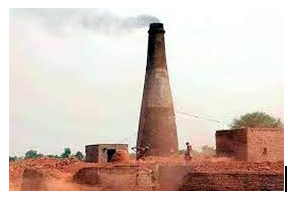INP-WealthPk
Muhammad Luqman
Haji Muhammad Ikram, the owner of a brick kiln located on the outskirts of Pakistan’s eastern city of Lahore, proudly noted that his chimney no longer emits black smoke and the fuel cost has also come down by 40%. This change, he attributed to the technology he first witnessed in kiln clusters dotted across Nepal’s districts of Bhaktapur, Dhading, and Biratnagar, where the design and construction of zigzag kilns – a new configuration – are producing high-quality bricks at lower costs and with fewer harmful emissions.
“Along with other kiln owners from Punjab, I visited Nepal and had firsthand knowledge of the zigzag technology,” Ikram, whose kiln was the first to embrace this green technology in Pakistan, told WealthPK.

He said that zigzag technology refers to a design and firing method that improves energy efficiency and reduces pollution by stacking bricks in a zigzag pattern. Nepal’s International Centre for Integrated Mountain Development (ICIMOD) and the Federation of Nepal Brick Industries (FNBI) have been instrumental in the transfer of new kiln technology not only to Pakistan but also Bangladesh and India. Brick kilns rank among the most notorious sources of pollution in South Asia in general and Lahore in particular. They emit thick black smoke filled with carbon monoxide, sulphur dioxide, and particulate matter such as black carbon.
Lahore has been a victim of environmental pollution round the year, and smog that has brought life to a halt every winter for the last decade. Brick kiln smoke, along with transport emissions, industrial gaseous exhausts, paddy stubble burning and cross-border smoke has been billed as the cause of air pollution in Lahore and other cities of the central Pakistan. Due to hazardous air quality, Lahore remains the most polluted city in the world during December and January. Punjab Environmental Protection Department, in collaboration with brick kiln owners, has minimised emissions during the brick manufacturing process by promoting zigzag technology in this part of the world.
“Now most of the 10,000 brick kilns in the province have been converted to zigzag technology, thus minimising the contribution of this sector to air pollution,” said the spokesperson of the department, Sajid Bashir, while talking to WealthPK. He said that the Punjab government is allowing only those brick kilns to operate, which are equipped with zigzag technology. “Non-compliant brick kilns are demolished as a punishment,” Bashir said.
According to environmentalists, the problem of air pollution should be dealt with in a holistic manner. “Brick kiln emissions are just a contributor to the air pollution. Most of the toxic exhausts are produced by ever-increasing traffic on Lahore roads,” Naseemur Rehman Shah, a former director of the environment department, said.
He said that efforts should be made to ensure that only well-maintained vehicles are on the roads, so that no additional smoke emissions are added to the air. He said that vehicle inspection service centres should be activated across the Punjab province so that smoke emitting vehicles remain off the road. Rehman said that National Environment Quality Standards (NEQs) should be implemented in true letter and spirit to achieve the target of a clean atmosphere in the country.
He said that urban forestry like Miyawaki forests could be another way to overcome the problem of air pollution. “The more the vegetative cover, the greater will be the chances of clean and healthy air in the city,” Rehman told WealthPK.
Credit: INP-WealthPk













